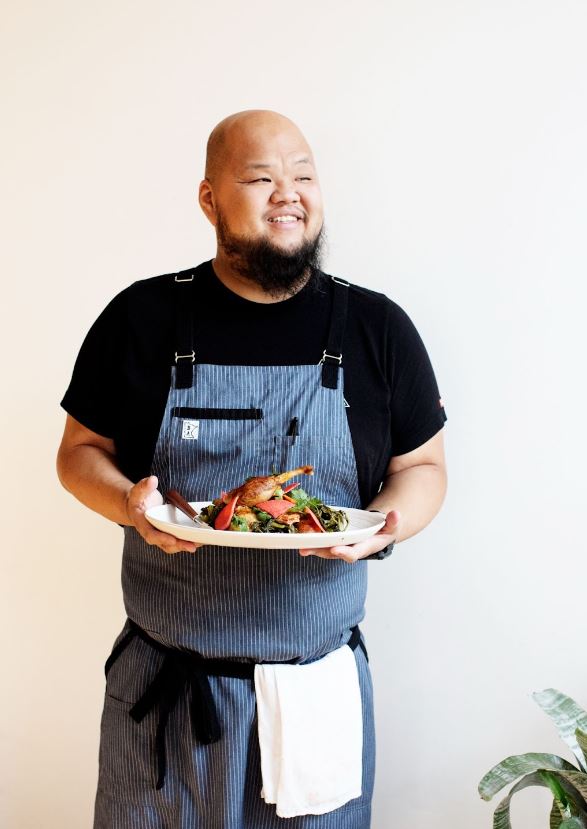By Rachel Kim
Becoming the nation’s leading Hmong American chef was not part of the plan for Yia Vang. Named EATER’s “Chef of the Year” and a James Beard multi-nominee, Chef Vang enjoys exploring the cultural DNA of Hmong cuisine and the journey of forging his Hmong roots to his culinary ventures.
Hmong food gleans from a variety of regional Southeastern ingredients due to a complex history of settlement. It shares a similar flavor profile as Chinese, Thai, Laos, and Vietnamese, Yet, what singularizes Hmong cuisine from other Asian flavors, Vang believes, lies in the way the people prepare and eat the food.
He spoke to AsAmNews about his culinary journey and the importance of sharing his Hmong culture with the general public.
In Hmong cuisine, Vang mentions that cohesion occurs when there are all four elements present on the table – protein, vegetables, hot sauce, rice – as each element plays a role as it did during the mid-70s and early 80s.
“If you’re missing one of those ingredients, or one of those elements, my parents actually don’t consider you having dinner or a meal. They consider [it] a snack, because there’s the cohesion between all of those four elements. The reason why there’s a cohesion is that it actually echoes the way that our people have survived,” said Vang.
Let the food tell the story
Vang believes that to truly understand the food, one needs to understand the cultural and historical backdrop of that country’s cuisine.
“You want to know our people, you have to know our food because our cultural DNA is intricately woven into the foods that we eat,” said Vang.
Hmong people are an ethnic group in East and Southeast Asia that migrated from Southern China to the highlands of Laos, Vietnam, and Thailand during the 19th century. Vang and his family were among the thousands of Hmong refugees who were forced to relocate to mostly Thai refugee camps after the Vietnam War.
Currently, Minneapolis-Saint Paul or the Twin Cities area is home to the nation’s largest Hmong population. Among them is Vang who is leading the American scene of Hmong food while tying back the concept of home into his dishes.
“From the moment we met, he is an articulate and thoughtful tastemaker and rising leader in the Twin Cities food scene. I was in college when the Hmong people were first resettled in Minnesota and Hmong restaurants started popping up around town. Today, it’s part of the fabric of our community, and Yia is at the forefront of that,” said executive producer Patrick Weiland who works on the show Feral on the Outdoor Channel with Vang.
In the world of food, there are two kinds of Hmong people, says Vang. First are the “hardliners” who strictly believe there must be one exact ingredient or method to prepare a dish, and the second are folks who believe Hmong cuisine is a mix of other cultural cuisines or, to some extent, a “mutt”.
“Both sides of it, if you really look at it, are not really digging into our food identity or who we are. What both sides really do is they neglect thinking outside the box,” said Vang.
It is also on this spectrum of strict and loose interpretations around Hmong cuisine that Vang finds a dissonance between authenticity and tradition.
Bringing ‘home’ to the table
Those preparing a dish in a location distant from its country of origin may occasionally encounter the question of authenticity and what it is that makes the dish ‘traditional’. Vang does not believe in the dichotomy of authenticity versus tradition – in fact, he wants to rule out the word “versus”.
“What if I told you that food and cooking from who you are inside is not actually about the food in front of you, but it’s about what was put into it,” said Vang.
The ingredients available to Vang in Minneapolis are not accessible to him in the mountains of Laos. Vang learned how to use root vegetables in the Twin Cities – the same way his parents would have done 75 years ago. For instance, the fermented Hmong mustard greens Vang uses for his restaurant in St. Paul, Union Hmong Kitchen, are harvested from his parents’ ten-acre garden. Finding whatever ingredients were available, Vang has studied how to progress authenticity within Hmong dishes.

“I’m unapologetically Hmong. I speak the language; I know the tradition. But because I can’t get the right kind of Thai basil to make a dish, am I less Hmong? Absolutely not. Our parents didn’t fight for us to get to this country so that we can just stay stagnant. They got here so that we can forge forward,” said Vang
A tribute to his people
Vang says that every dish has a narrative and to follow that narrative for an extended period eventually leads to the people behind the food. And where there is food, there is opportunity. Vang sees that opportunity as a “catalyst into cultivating great relationships”.
Vang sees these relationships as an opportunity for non-Hmong folks to familiarize themselves with the cultural intricacy of Hmong cuisine – starting with the menu.
At Union Hmong Kitchen, the menu uses Hmong words, and Vang has intentionally kept it that way. Behind the naming process of a dish, Vang has wanted to create a space for his employees and Hmong diners where they could be the experts of the language while teaching phrases like “kua txob” (goo-at sah), or pepper sauce, and “zoo siab” (zhong she-ah), or “happy”, to non-Hmong visitors.
“Naming is very important. It also helps the younger generation that are Hmong who doesn’t speak Hmong…to iterate this is important,” said Vang.
Mastering his father’s Hmong sausage and his mother’s fermented hot sauce recipes before incorporating them into his Zoo Siab meal, Vang has uncovered his philosophy in the food he had once been ashamed of, observed, consumed, and eventually grown to love.
“Everything I learned about grilling, cooking over a wood fire – everything that I’ve learned about what it means to take care of people and how to ferociously love people came from my father and my mother’s heart,” said Vang.
Vang’s new restaurant Vinai is slated to open in central Minneapolis by Spring 2024. The name “Vinai” derives from Ban Vinai, a Thai refugee camp that housed thousands of Hmong refugees after the Vietnam War – and Vang’s birth place.
His parents, now retired, are also part of the process.
“This is where my life started. The way that they simply sat in a refugee camp for 10 years…now we get to take everything from them for what they’ve given us, and now we get to share with people. And the vessel I use is food,” said Vang
‘Feral’ Season 2, Podcasts, and more

Vang returns with season 2 of his hit Outdoors Channel series Feral with new episodes coming out each week. While Feral features hunting and cooking exotic and invasive species, Vang believes the show is a “clashing of cultures” where he also gets to talk about Hmong culture to people who have never heard of it. Vang and the camera crew once traveled to Taos Pueblo in New Mexico and bonded with an indigenous group.
“If the audience connects with a host, they’ll follow them anywhere. Think Anthony Bourdain or Andrew Zimmern. I believe Yia has that same ability to connect on a very personal level with viewers. He’s vulnerable, honest and incredibly talented and is someone a viewer would want to hang out with. It just so happens, on that journey, they get to learn about the Hmong people, their culture and food. That’s the true power of television to help people step outside themselves and connect with others. We need more of that today,” said executive producer Weiland from Vang’s show Feral.
Vang also leads the podcast series Hmonglish. He previously competed on Netflix’s Iron Chef: Quest for an Iron Legend, cooking only Hmong food, and hosted the digital Food Network’s Stoked.
In a word of advice to the Asian American community, Vang briefly shared his own experience with the “Lunchbox moment”, before offering speaking to the younger generation who also struggle with connecting their identity to food.
“When the kids who used to make fun of you, they are going to come ask you about it. You have two choices. One, you can reject them or two, you open up their hearts, and you open up your hearts. And what you say to them is, ‘hey, welcome to the family’ like ‘sit at the table with us,’” said Vang. “I believe that hate begets hate, that begets more hate, and fear begets fear, that begets more fear. And what overcomes all of that? Love.”
AsAmNews is published by the non-profit, Asian American Media Inc. Please take advantage of a $30,000 matching grant challenge. An anonymous donor has offered to match dollar for dollar every tax-deductible donation made to Asian American Media Inc from November 1, 2023 until the end of the year. The money will be used to fund the addition of a new reporter and to produce content for limited English-speaking Asian immigrants. We are supported in part by funding provided by the State of California, administered by the California State Library in partnership with the California Department of Social Services and the California Commission on Asian and Pacific Islander American Affairs as part of the Stop the Hate program. To report a hate incident or hate crime and get support, go to CA vs Hate.




